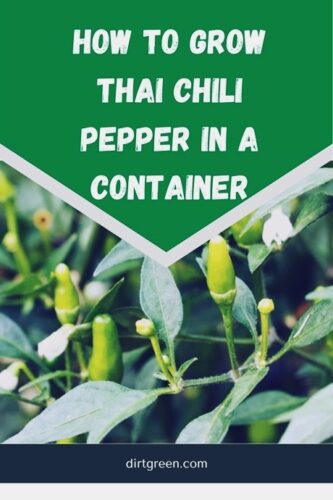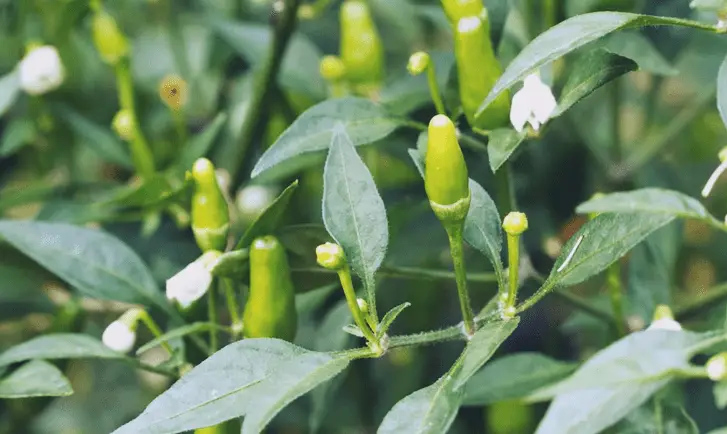Today we will take a practical look at how to grow hot Thai chili peppers in a container.
This method also works for raised beds or on the ground in your backyard garden.
Hot Thai chili pepper is one of the hottest peppers most people love as a seasoning for their food.
It is easy to grow and will definitely turn up the heat in your mouth.
There are many different types of Thai chili peppers out there.
Just to name a few, we have Guajillo chili pepper, Chile de Arbol, Serrano pepper, Pequin Pepper Prik Nee Noo, and so on.
However, most people just call them hot chili peppers when they are seen at the supermarket because it’s difficult to tell them apart at times.
So, here is what you need to know when it comes to growing Thai hot chili pepper in a container.
The same principles can be applied to raised beds or even your backyard garden.

How To Grow Hot Thai Chili Pepper in a Container
Container Potting Mix (Compost)
The compost potting mix I use to help the chili pepper plant get a lot of nutrients and grow great is:
- Perlite 20%
- Peat Moss: 20%
- sandy compost soil 20%
- Chicken or cow manure: 5% (Optional)
These are just some examples of what you can use for your potting mix. There are many more organic mixtures you can use.
Just ensure that each organic matter is equally evenly distributed in the potting mix. That way, your chili pepper plant will have all the nutrients it needs to grow.
When should I transplant the Thai chili pepper plant into a container?
The recommended time to transplant young Thai chili peppers from their starting cells is when they are around 4 inches tall.
That is approximately 8 to 10 weeks from the day they started to germinate in their starting cell tray.
However, it all depends on the time frame, the climate, and the nutrients put into care that determine how to fit your Thai chili pepper plant for transplanting.
Not all chili pepper seedlings will have the same height when it’s time for transplanting.
So, some of your seedlings may be taller or shorter in height, depending on certain factors.
Recommended Container Size For Thai Chili Peppers
A 6-gallon container is an ideal size to grow a single Thai chili pepper after transplanting it from its starting cell.
So, since the Thai chili pepper plant grows around 15–20 inches tall or more, 6-gallon containers can get the job done.
Your container can be much larger if you don’t have a 5-gallon size.
For people who would rather plant chili in the natural soil, just ensure that you mulch around the plant root and apply the fertilizer once per month.
Adding a little fertilizer to the chili pepper plant root will boost and supply all the sufficient nutrients the plant needs to grow healthily.
Fertilizers to Use:
- Tomato Fertilizers
- Other Regular Vegetable plant Fertilizers
It’s quite easy to make fertilizer, especially tomato fertilizer, which aids in many other plant growth. To learn more, here’s a comprehensive guide on how to make your own tomato fertilizer at home.
What insects affect the Thai chili pepper plant?
One of the main insects that affect Thai chili peppers is the whitefly.
Although the chili plant does not regularly have many insects or pest issues,. Whiteflies will attach and lay their eggs under the leaves of the plant.
How To Get Rid Of Whiteflies On The Chili Plant Leaves
The number one way to get rid of whiteflies is to use plant pesticides, such as.
Organic Neem Oil: Mix one gallon of water with the Neem oil on plant leaves to kill the Whitefly larvae found under leaves
When is the best time to plant hot Thai chili peppers?
The best time to plant hot chili peppers is during the spring and into the summer. In which month should you plant hot chili peppers? (May–September each year).
Chili peppers usually produce more peppers in warm to moderate climates.
Although chili peppers can grow and produce in the writer’s time, they may not produce as much as they would in warmer temperatures.
A temperature of 60–80 degrees is suitable for Thai chili peppers.
When Is the Right Time To Harvest Thai Chili Pepper?
The best time to harvest Thai chili pepper is when the pepper has a green color.
When Thai chili peppers turn red in color, they build up more heat and can be extremely hotter than their greener state.
So, it all depends on how hot you want your chilies to be.
If you want your peppers to be extremely hot, it is ideal to wait until the green chili pepper turns red in color.
You can also dry the hot chili pepper to grind it into a hot chili powder substance.
Once you have applied all the necessary care and procedures stated in this post, your Thai chili pepper plant will thrive and produce spicy chili peppers.
How hot is Thai chili pepper?
The Thai chili pepper is 50 to 100 times hotter in the Scoville heat units than other regular chili pepper varieties.
This is incredibly hot for a single fruit, however, most people usually compare the jalapeno pepper to the chili pepper.
Nonetheless, the jalapeno pepper is about 8k Scoville heat units less hot than its native Thai chili pepper.
So, there you have it. I hope all the information provided in this post is somewhat helpful to you in your quest to grow Thai chili peppers in a container or backyard garden.
Stay healthy and keep planting.
Related Post: Growing Bush Cucumber in a Container




